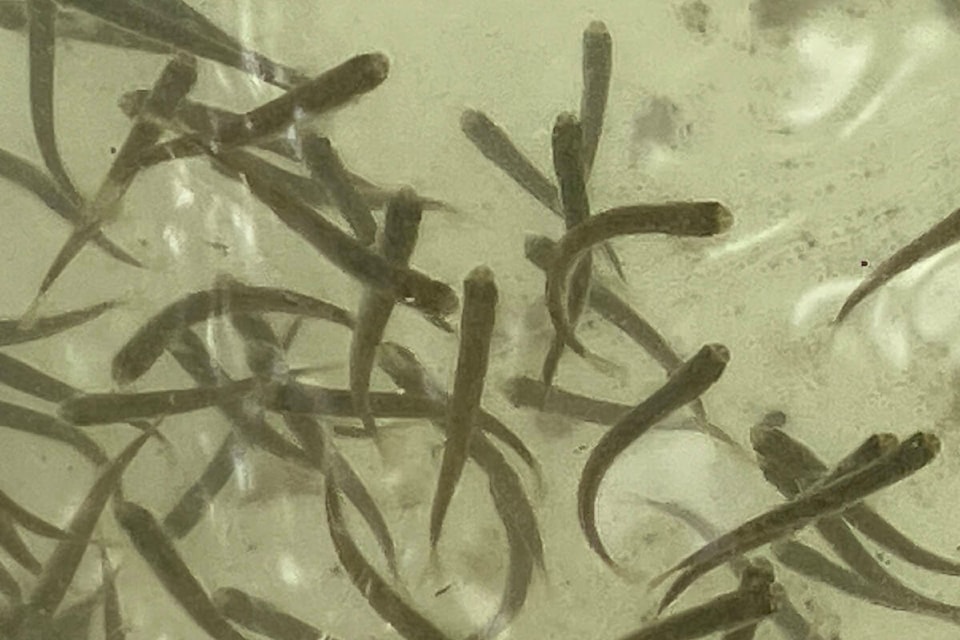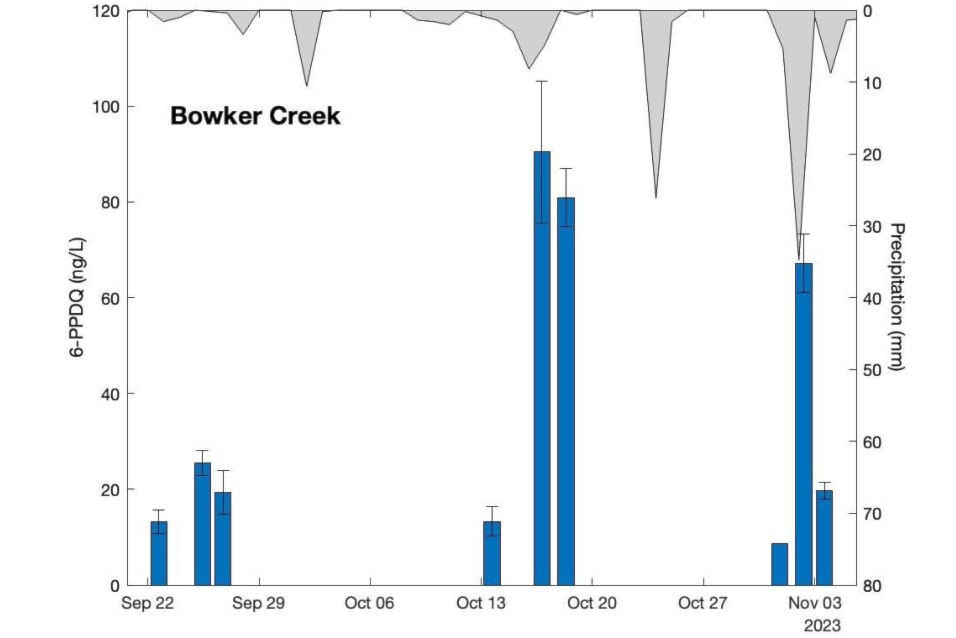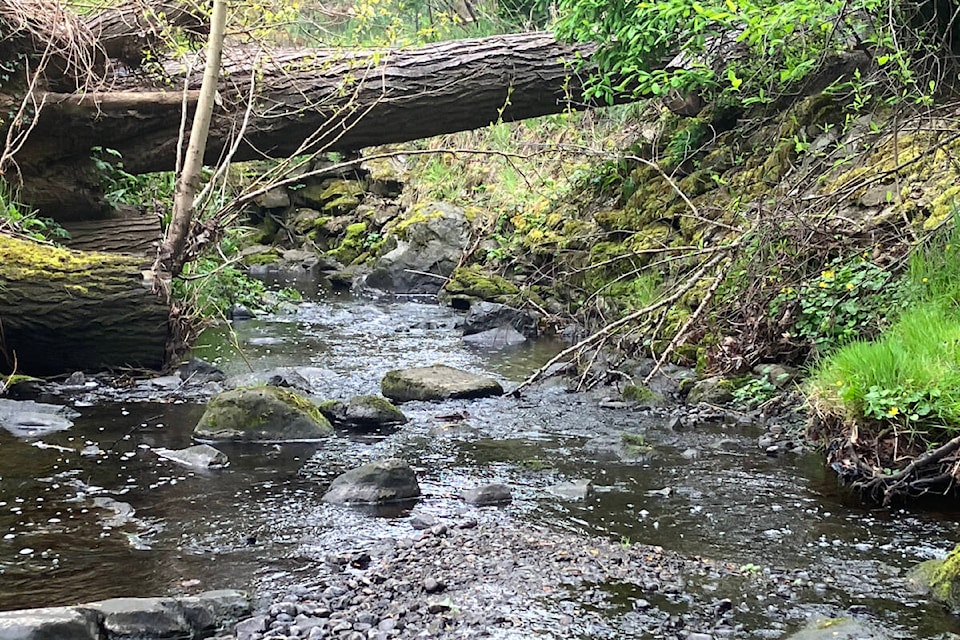When heavy rains hit Greater Victoria, a handful of volunteers scurry out of their homes during various stages of the storm to gather water samples from Bowker Creek.
They’re perhaps the soggiest people involved in a deeper look at the impacts of something called 6PPD-quinone on waterways across the Island with the B.C. Conservation Foundation in partnership with Vancouver Island University (VIU). Recently identified as a toxic chemical, 6PPD-quinone is widely used as a stabilizing additive in rubbers such as tires.
The Friends of Bowker Creek are among 20 stewardship groups and First Nation partners sampling waterways from Campbell River to Victoria and west to Lake Cowichan as part of a study into the compound widely used as an additive in rubbers commonly found in vehicle tires.
“By working with these groups, we’re able to look at a wide range of systems – in both urban and rural settings to identify the largest 6-PPDQ inputs for targeted remediation,” said Haley Tomlin, a biologist with the B.C. Conservation Foundation, which partnered with the VIU’s Applied Environmental Research Lab.
They’re also coordinating efforts with groups at the University of British Columbia and the Department of Fisheries and Oceans Canada, which is sampling on the mainland.
“Since there are thousands of potential inputs of tire wear toxins into fish-bearing streams on Vancouver Island, the involvement of community groups and First Nations is essential,” said Tomlin.
“These groups hold a great deal of knowledge about local waterways, potential sources of roadway runoff, and fish populations, past and present. This data is adding to our understanding of when and where these toxins are making their way into natural waterways.”
READ ALSO: Rubbery pellets shedding from Oak Bay High field threatens nearby creek
Friends of Bowker Creek monitor the waters for several other things, such as nitrates, pH, dissolved oxygen and fertilizer pollution.
These tests are inexpensive and accessible for a non-profit community group.
“Those are the core things we worry about basically because they are ones we can do something about, and that we can afford to measure,” said Eldan Goldenberg, a Vic West resident and Friends member spearheading the local contingent.
Those results are shared openly online at app.waterrangers.ca/groups/friends-of-bowker-creek-salmon-recovery.
Water Rangers is a Canadian non-profit that provides test kits and shares open data to support communities monitoring local waterways. The general water quality studies are intentionally done at various times to get a general picture, on different days and times of day.
Testing for 6PPD-quinone would be cost-prohibitive without the B.C. Conservation Foundation and VIU partnership, Goldenberg said.
The project team leaves test kits with volunteers who live near the creek that meanders through Saanich, Victoria and Oak Bay. When heavy rains are forecast, those volunteers go out and get three samples.
“They come and pick it up along with samples from a load of other creeks around Vancouver Island and take them back to the lab,” said Goldenberg.
Goldenberg first started hearing about 6PPD-quinone three or four years ago, about as long as he’s been active with Friends of Bowker Creek.

“It’s toxic to coho salmon in particular in really small concentrations. It’s also weirdly species specific,” he said. One of the group’s key projects is to restore salmon to the creek. While so far they’ve sent chum fry out to sea, coho is in the future – albeit far in the future.
“Right now we have a dream of introducing coho one day, but there are so many things that need to be done … it’s more important to us that the field advances.”
READ ALSO: Out of the streambed gravel comes harbinger of waning pollution in Oak Bay creek
With two local storms under the group’s belts, data from one has already provided preliminary results. Although it is too early to draw specific conclusions from the data so far, the group has analyzed more than 700 stream samples since late September.
“We do observe elevated concentrations of tire wear toxins in a number of streams on Vancouver Island, particularly in urban settings. Concentrations generally peak during rain events consistent with roadway run-off and stormwater inputs. Our group has recently shown that these toxins can be leached into water from tire crumb materials and may be removed using certain sorbents. We are working with civil and environmental engineers to develop low-cost, nature-based materials to treat stormwater,” Tomlin said.

The database will be accessible through the project website tireweartoxins.com.
READ ALSO: Non-profit groups monitor for sunscreen contamination in Cowichan watershed
The team’s short-term goals are to identify major tire wear toxin sources along the east coast of Vancouver Island, investigate tire wear toxin variation over time and space, evaluate green infrastructure and nature-based solutions.
The group also wants to sponsor an annual symposium bringing together local First Nations, stewardship groups, all levels of government, and academic researchers to share findings and educate the community.
Long term they hope to identify major tire wear toxin inputs and prioritize sites for future mitigation efforts, learn ways to mitigate tire wear toxins and raise awareness of the issue within the community as well as all levels of government.
The project is funded to 2026.
While pollutants remain a worry, among the largest concerns for the Friends of Bowker Creek remains the rise and fall of water in Bowker Creek – which can happen too rapidly three seasons of the year.
“Because there’s so much impervious surface it doesn’t take that much rain to fill the culverts and get the creek raging,” Goldenberg said.
Interestingly, among the solutions for slowing that process is rain gardens are also helpful for 6-PPDQ.
While it comes appears to be byproduct of tires wearing out, it doesn’t accumulate and breaks down quickly.
“Things like rain gardens can make a big difference. Anything that slows the rain down by one day … is enough that will allow the 6-PPDQ break down.”
